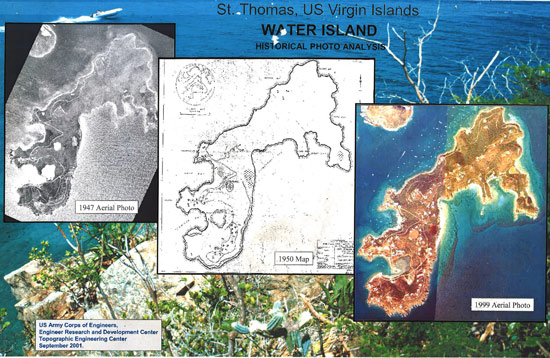Military History of Water Island
1900-1950
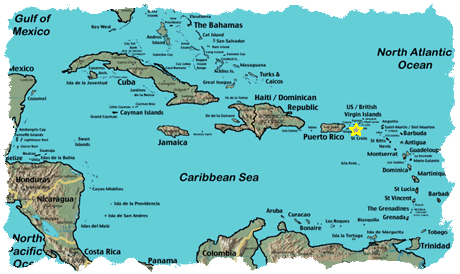
Here stands little Water Island. A tiny 500 acre island in the Caribbean Sea. Just a little speck really. It kind of makes you wonder why the World War II U.S. military spent $1.6M (about $19M in 2010 dollars) between 1940 and 1946 to build an elaborate array of defensive positions and ancillary support facilities. What could be so important for this speck of an island to become a military outpost during the “War of Our Fathers”?
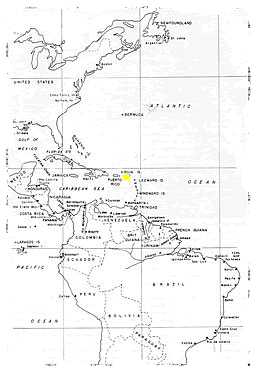
In order to understand why Water Island was considered to be of tactical value to the United States military, we must look for a moment into the strategic value of the Caribbean and later the U.S. Virgin Islands. We need to go back in history a bit to get perspective. Historical events provide the building blocks leading to the Water Island role in defense of the Caribbean in World War II.
As you read the history related below, you will see paragraphs in red italics. These sections highlight other major military events taking place at the time to give wider context.
So let us go way back to 1860 to 1900
Secretary of State Seward realized the value in the Danish West Indies after blockade running in the Civil War was facilitated by the weaknesses of the navy in the West Indies. Seward wanted to obtain the harbor of St. Thomas by purchasing the Danish West Indies. In October 1867, a treaty was signed selling St. Thomas and St. John (not St. Croix) to he U.S. for $7,500,000. However, the U.S. Senate did not ratify the treaty and in April 1870 the treaty lapsed. ((Note: Seward did negotiate a treaty and the Senate ratified the purchase of Alaska from Russia (Seward’s Folly) 0n 9 April 1867 for $7.2M-1.9 cents per acre.))
The first stage of the Panama Canal construction was started by the French in 1881 and continued through 1888.
On 15 February 1898, the American battleship USS Maine suffered an explosion and quickly sank with a loss of 260 men in the harbor of Havana Cuba. The U. S. Congress declared on 25 April 1898 that a state of war had existed with Spain since 20 April 1898. The Spanish American War ended in 1898. The United States took control of Puerto Rico, Cuba, Guam and the Philippines.
Period of 1900-1930
Despite continued naval recognition of the value of St. Thomas, little was accomplished until 1898 when rumors that Germany contemplated establishing bases in the Caribbean. A second treaty to purchase the Danish Virgin Islands was signed on 24 January 1902 with a purchase price of $5M. However, again this treaty was never approved this time by reluctance in the Danish legislature later in 1902.
In 1905, the East Asiatic Company purchased Water Island. ((Note: 1905 U.S. Consular Dispatches, Payne to Pierce, 4 February 1904; The American consular representative in St. Thomas shared a prevailing opinion that the East Asiatic Company (reportedly controlled by Germany’s Hamburg American Steamship Line) was actually fronting for the German Government, which was surreptitiously endeavoring to establish a German commercial and naval base on St. Thomas.)) If this was true, the East Asiatic Company may have acquired Water Island in order to guarantee its long-term availability for the exclusive use of the German Navy. Around the same time, the East Asiatic Company acquired the West Indian Company and decided to expand and upgrade the docking and coaling facilities in Long Bay. Nothing happened on Water Island.
WW I and the 1917 sale of the Danish West Indies to the U.S. put to rest the company’s plans for Water Island.
The U.S. took over construction of the Panama Canal in 1904 and eventually completed it on 7 June 1914.

World War I began on 2 August 1914 when German troops crossed the border into France. The U.S. entered the war on 6 April 1917 shortly after Germany declared unrestricted submarine warfare. German delegates sign the Treaty of Versailles on 28 June 1919 ending World War I.
A radio station and submarine base was established on St Thomas during WW I.

A third treaty to purchase the Danish West Indies for $25M was signed on 4 August 1916. At about 5 P.M. on March 31, 1917, the transfer of St. Thomas, St. John and St. Croix was concluded with a ceremony held in Charlotte Amalie ($25M in gold). Water Island was NOT included in this purchase. Administration of the Virgin Islands was placed under the Department of the Navy.
In 1916, the Aluminum Company of America (Alcoa) bought the bauxite fields in Surinam (northern coast of South America) Bauxite ore is used for the production of aluminum.
A detailed map of Water Island from the first U.S. Geodetic Survey in 1918 is shown below.
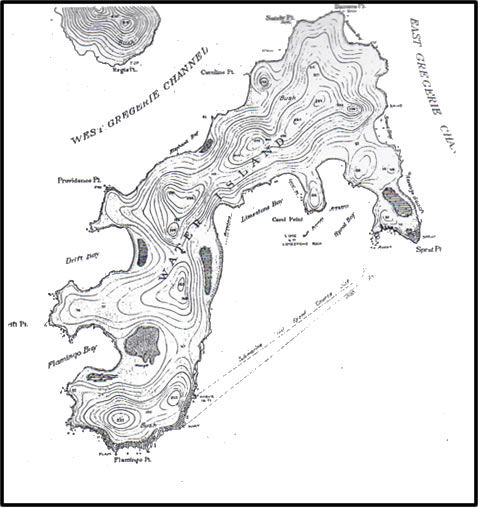
Geodetic Survey Map of St. Thomas compiled in 1918
[USC&GSO, 1919]
The Pre-World War II Era
During the 1930’s, ideas were floated in the U.S. political arena regarding the national defense value of the European colonies in the Western Hemisphere, primarily the West Indies. On 30 August 1935, the Secretary of War stated that St. Thomas lies on the direct steamer lane between European ports and the Panama Canal, and that St. Thomas is admirably suited to act as a refueling station and dry dock facility.
In 1931, the WW I naval station on St. Thomas was closed. The jurisdiction over the Virgin Islands was transferred to the Department of the Interior.
In 1935, a Marine Air Base was established on St. Thomas. Bourne Field comprised two 1,600 feet sod surfaced runways used as a training field.

World War II
The world changed forever when on 1 September 1939, Germany invaded Poland and executed its first “Blitzkrieg” (Lightning Attack). France and Germany entered the conflict on 3 September 1939. On 15 March 1939, Germany occupied Czechoslovakia and on 22 May 1939, Germany and Italy sign a formal alliance.
In 1939, the Navy leased 225 acres to build a submarine base in the area now known as Crown Bay.
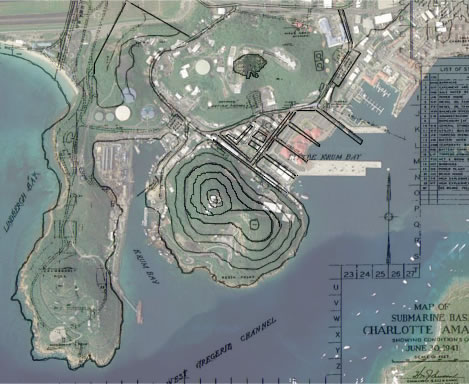
By the end of 1939, the oil refineries on Aruba and Curacao supplied 43% of the British and French oil requirements. U.S. was also a user of oil passing thru the refinery (owned by Esso Oil) at the port of Lago, Aruba.
German troops invade the Netherlands, Belgium and Luxembourg on 10 May 1940. Winston Churchill becomes Prime Minister of Britain. German troops enter Paris on 14 June 1940. Charles deGaulle, from London, becomes the Leader of the Free France.
As late as May 1940, the War Department, at least on the surface, insisted that the potential military value of the European West Indies colonies was not sufficient to justify discussion. The United States was consistent in its isolationist view to stay out of the turmoil in Europe. But the rapid advance of German armies through France in June 1940 changed the perspective of the strategic value of additional Atlantic bases. Isolationism disappeared. What had been discounted in May 1940, now in June 1940 became a part of a plan for hemispheric defense.
This press clipping from the St. Petersburg Times, March 8, 1940 edition, shows that someone was thinking about the value of additional bases in the Caribbean.

On 10 June 1940, the Battle of Britain begins with the first great German air attack. The German battleship ‘Bismark’ enters service on 24 August 1940. The Selective Service Bill was signed by President Roosevelt on 16 September 1940, beginning the first peacetime draft.
For more than a century before, WW II harbor defenses constituted the primary means for seacoast defense. Their purpose was to defend the harbor against capture, to protect the area from naval bombardment and submarine torpedo attack, and to cover the seaward approaches to naval anchorages.
In July 1940, efforts were initiated to further develop Bourne Field and the long since abandoned radio station and submarine base. The initial program called for improvements and additions to facilities to house a Marine squadron of 18 planes on a permanent basis. The main runway at Bourne Field was extended to 4,800 feet and additions were made to hangers, housing, cold storage, gas storage and a new 60 bed dispensary and hospital. A concrete ramp was built to accommodate seaplane operations in Lindbergh Bay.
A 27 July 1940 report recommended the adoption of the 16” gun as the primary harbor defense weapon supplemented by the 6” gun (Note: the 6” gun was to be installed on Water Island).
Looking at the map below you can see island stepping stones that curve in the shape of a bow enclosing the Caribbean Sea. Then, look how the islands guard the Panama Canal, the short cut route between the Atlantic and Pacific oceans!
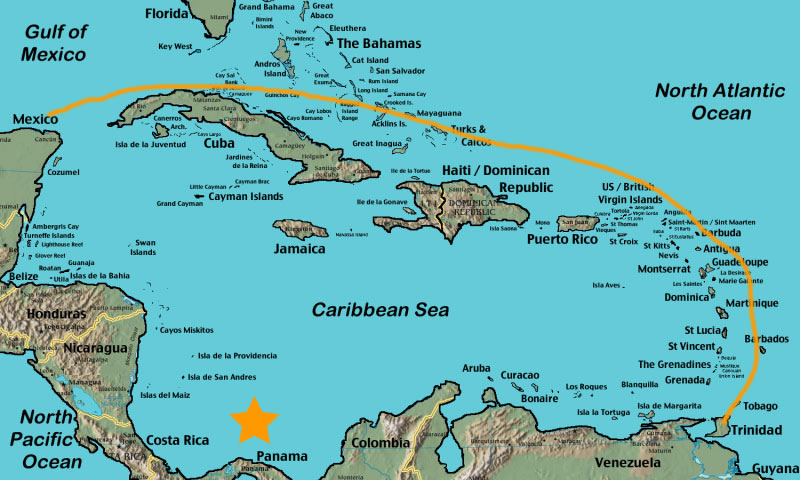
On 2 September 1940, the Destroyer Base Agreement was signed with Great Britain giving the United States the right to lease air and naval base sites in Newfoundland, Bermuda, the Bahamas, Jamaica, St. Lucia, Antigua, Trinidad, and British Guiana. The Army Air Corp began a study of the airfields already being developed by Pan American Airways and included the newly acquired leases in the West Indies. Small permanent military garrisons were recommended that could be readily expanded in an emergency. Rapid communication among the islands and the United States was critical as an early warning network.
French Marines arrived on Aruba on 11 May 1940 with British troops arriving on Curacao on 13 May 1940. Note: when the French capitulated to the Germans, the British took over on Curacao and St. Martin).
Newfoundland on the northern flank, Trinidad on the southern and Bermuda in the center were the first Atlantic bases to be established with soldiers arriving in Newfoundland in January 1941. In April 1941, the first units were dispatched to Bermuda and Trinidad. By May 1941, the Army had been provided $163.8M with priority going to airfields, communications and housing on the leased islands. Further occupancy of the West Indies islands was stalled as the U. S. was convinced that Great Britain and the British Fleet would hold out making it less urgent to man the bases as outlying stations of U. S. defense.
Erwin Rommel, popularly known as “The Desert Fox”, arrived to command German forces in North Africa on 12 February 1941. British aircraft sink the ‘Bismark’ on 27 May 1941. On 24 July 1941, the Japanese occupy French Indo-China (now Viet Nam).
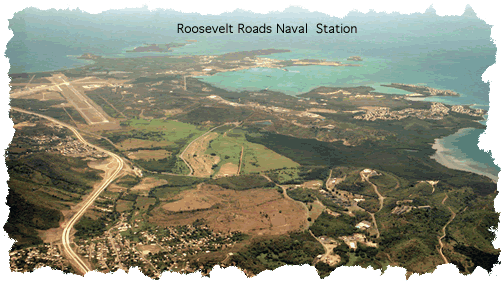
In the summer of 1941, construction started on Roosevelt Roads, Puerto Rico which became a major Navy Base and Naval Air Station. Future military development of St Thomas and Water Island were closely tied into the major base as Roosevelt Roads. In 1941 (date unknown) the War Department stated the need for artillery and other support for the Submarine Base on St Thomas. Artillery and searchlights were proposed for Water Island.
During the summer and fall of 1941, garrisons were established on British Guiana, Antiqua, St. Lucia and Jamaica as construction had progressed to a point to support troops. German destroyer and U-boat activity rapidly built up in the Northern Atlantic.
On 8 July 1941, further additions were started on Bourne Field and a Submarine Base on Gregerie Channel. Built within dredge-deepened water, the St. Thomas Submarine Base comprised three finger piers (each 350’ x 30’) and twelve dolphins. Construction included housing for nearly 1,000 men, an administration building, storage buildings, a torpedo overhaul shop, a bombproof powerhouse (four 750 KW diesel generators), and diesel storage tanks (two 10,000 galloon). Five hillside catchments were built (totaling 13 acres) and rainwater was funneled into a number of reservoirs.
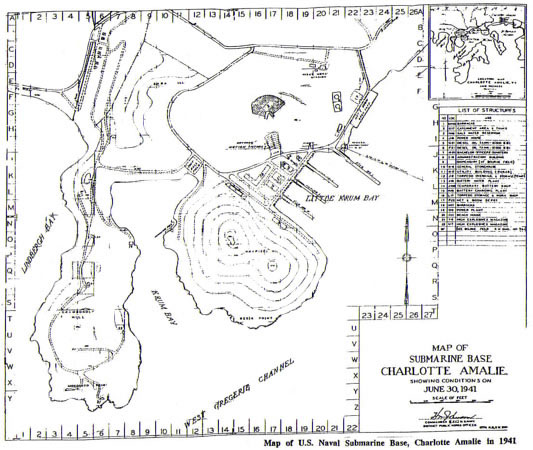
In October 1941, the St Thomas Submarine Base was further expanded to include a net and boom facility. By December 1941, the runway at Bourne Field was paved.
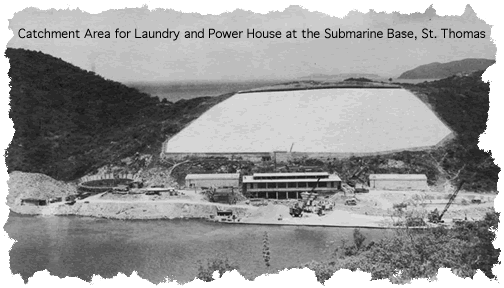
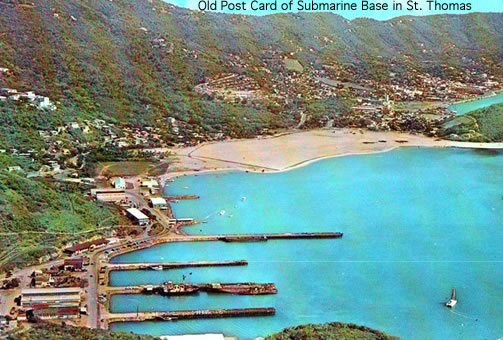
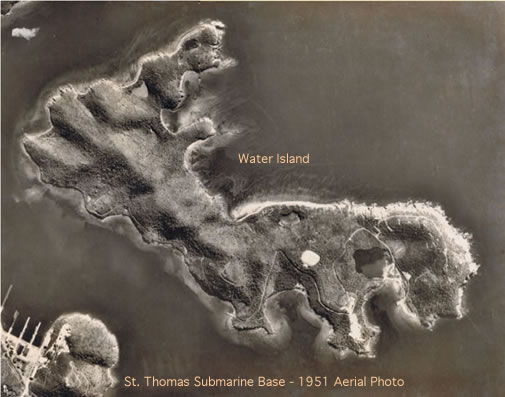
Note: more research is being done on the St. Thomas Sub Base boom and net. Click here to see photos of a typical boom and net installed by the navy to augment Army harbor defenses.
First U.S. troops arrive Surinam on 25 November 1941 to protect the bauxite fields-aluminum critical to the production of aircraft. Later in 1943, U.S. troops occupy the bauxite rich countries of French and Dutch Guiana (Guyana)
Japanese aircraft launch surprise attack on American naval forces at Pearl Harbor, Hawaii on 7 December 1941. Responding, the U. S. declares war on Japan on 8 December 1941.
Germany and Italy declare war on the U. S. and signed a military alliance with Japan on 11 December 1941.
Based upon war planning, the Caribbean operations faced the Atlantic and anticipated a war in which Germany and Italy would be the major opponents, and the Caribbean would be relatively immune to attack. The highest probability was a carrier attack against the Panama Canal from the Pacific. Less than 60,000 men were stationed in the Caribbean Defense Command by the end of December 1941. Puerto Rico, unlike Panama, appeared to be out of reach of the Japanese. At the end of February 1942, only 22,000 men were stationed at the Puerto Rico garrison. Panama was the focus of attention. ((Looking ahead, the Caribbean Defense Command was built up to a peak of 119,000 men in December 1942. As it turned out, the Panama Canal was never seriously threatened from either side, nor were the Caribbean outposts, except for Aruba and Curacao)).
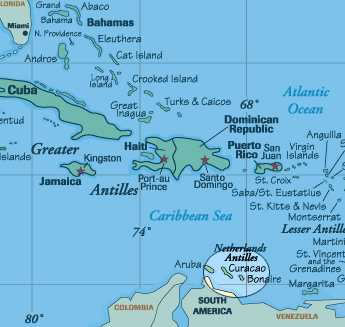
U.S. troops and bombers were stationed on Aruba and Curacao beginning December 1941.
Heralded by an attack on Aruba, the battle of the Caribbean took the form of sustained and extremely damaging U-boat assault against shipping in February 1942. Four British and one Venezuelan tanker were torpedoed and sunk while at anchor in the harbor of San Nichols, Aruba. Moments later, an American tanker tied up to the oil refinery was torpedoed.
Japanese forces capture Bataan, Philippines in April 1942. In June 1942, the Battle of Midway commenced. Lieutenant General Dwight Eisenhower took command of the U. S. Forces in Europe in June 1942. The air and sea battle of Guadalcanal continued in November 1942.
Early in 1942, construction of military facilities was started on Water Island. Similar facilities were planned for Culebra, but were never initiated.
1942 saw the Battle of Midway and the air-sea Battle of Guadalcanal. Lieutenant General Dwight Eisenhower was appointed Commander, US Forces Europe.
By the end of 1942, the German’ U-boats had sunk a total of 270 vessels in the Caribbean and the approaches to the Atlantic side of the Panama Canal. After January 1943, the German U-boats were never again a menace in the Caribbean only a nuisance. U-boats were redeployed to Europe and North Africa. Thus began a reduction in U.S. forces stationed in the Caribbean that continued throughout the remaining two and half years of the war.
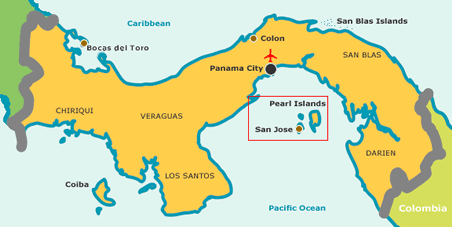
In 1943, the Army’s Chemical Warfare Service determined that a testing site in the tropics was needed to prepare for potential chemical battlefield activities in the Pacific theater. An island off the coast of Panama (San Jose Island) was chosen as the testing site. The testing to be conducted was to determine the effectiveness of chemical munitions under jungle conditions, to develop doctrine for the use of chemical munitions and to field test the munitions. The U.S. Government leased San Jose Island from Panama and a temporary camp was established in January 1944. Experimentation began in May 1944. The testing formed the basis of chemical warfare doctrine for the 1950’s and 1960’s.
On 6 June 1944, Allied Forces launch the D-Day invasion of Normandy, France.
In April 1944, the 818th Anti-Motor Torpedo Boat (AMTB) Battery occupied Water Island’s military facilities. The 6” gun unit was the #14th (note: further research ongoing).
As of 17 Jun 1944, the Water Island Battery had the bombproof underground fort and pillbox completed.

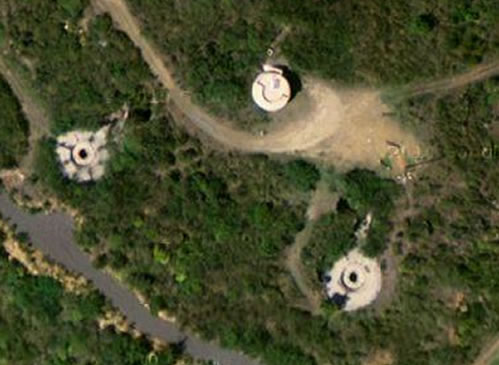
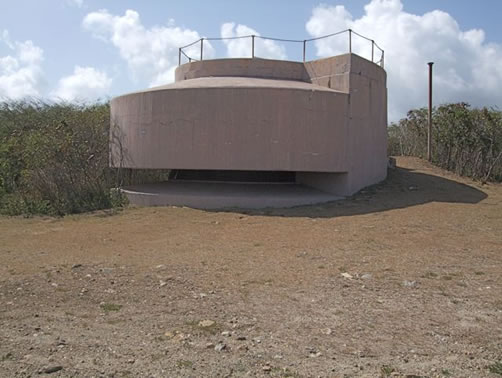

The 6” coastal artillery guns had yet to be installed. One searchlight (60”) station (Flamingo Point) and another (24”) at Providence Point were completed. At Providence Point two 40mm anti-aircraft gun mounts were under construction as well as two 90mm anti-aircraft gun mounts near Druif Bay.
See descriptions and pictures of: the 40mm Gun, the 90mm Gun, the 6”Gun and the Searchlights.
On 19 June 1944, the U.S. Department of Defense acquired Water Island from the East Asiatic Company (West Indian Company) thru condemnation proceedings (eminent domain) for $10,000 for the explicit purpose of establishing a coastal defense installation on the island. The military facility on Water Island was named Fort Segarra in honor of Lieutenant Colonel Rafael Angel Segarra (from Puerto Rico) a highly decorated WW I veteran.
Adolf Hitler commits suicide on 30 April 1945. On 7 May 1945, Germany unconditionally surrenders.
The world’s first atomic bomb was dropped on Hiroshima, Japan on 6 August 1945 (remember the B29 Enola Gay). The world’s second (and last) atomic bomb was dropped on Nagasaki, Japan on 9 August 1945.
On 15 August 1945, Japan unconditionally surrenders.

In early 1946 construction on Water Island was abruptly halted before the 6” coastal artillery and 40mm/90mm guns could be installed. Total cost was estimated at $900,000. December 1947 records show the value of construction on Water Island at $1,583,055.
Fort Segarra construction was discontinued on 1 July 1946.
Post World War II
If you recall from above, it was mentioned that in 1943 the Army’s Chemical Warfare Service determined that a testing site in the tropics was needed to prepare for potential chemical battlefield activities in the Pacific theater and that San Jose Island off the coast of Panama was selected for this testing. This came to an end in December 1947. This was not good news for Water Island.
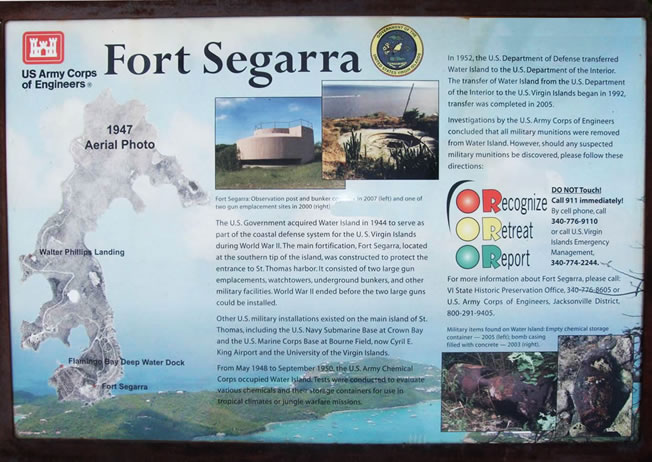
Experimentation was halted on 23 December 1947 when the lease for San Jose Island was not renewed by Panama. All equipment and personnel were moved by 28 January 1948 to temporary locations in the U.S. controlled Canal Zone, Panama. Immediately, exploration began to locate a new testing site. St Thomas was selected as the new site for the chemical testing activities.
By the end of May 1948, all the equipment, personnel and chemical munitions had been moved to St. Thomas into the former Navy Submarine Base. An area of about 2,095 acres, consisting of the entire west end of St. Thomas, was condemned for lease. Fort Segarra on Water Island was also included in this condemnation process.
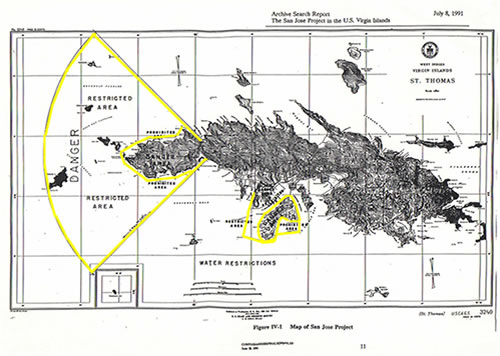
Between May 1948 And May 1950, the San Jose Project continued limited testing on St. Thomas and Water Island. Testing included mustard gas (blister agent) and phosgene (choking agent). Later tests were planned to shift to captured German munitions and nerve agents. While incomplete, records show that only non-persistent choking agents were tested on St. Thomas while persistent and lethal munitions appear to have been performed on Water Island. It appears that only a limited number of tests were performed on Water Island.
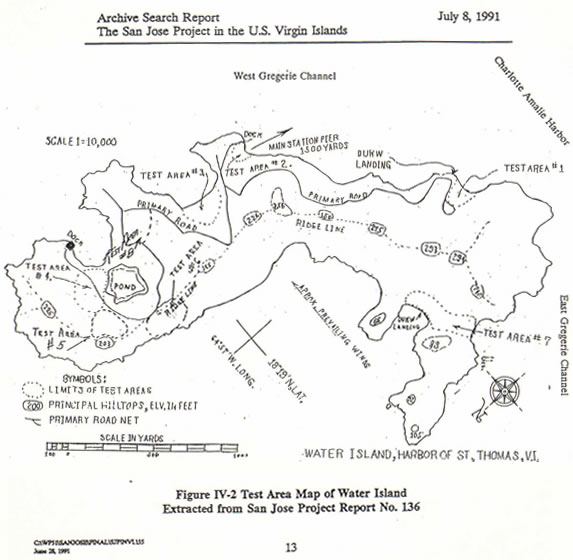
By September 1950, the San Jose Project in total was moved to Dugway Proving Grounds, Utah and the leased land on St. Thomas was returned to the Virgin Islands Government. The Army did retain a permit to use Water Island.
A map prepared on 31 August 1950 by the Army Corps of Engineers shows the remaining Army facilities on Water Island.

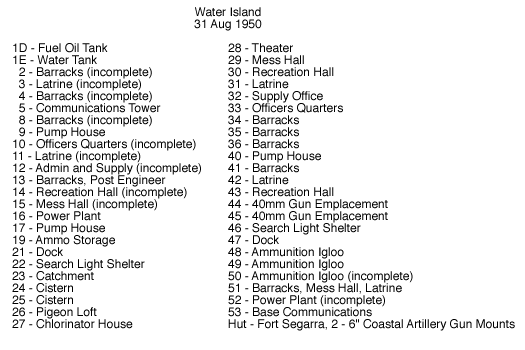
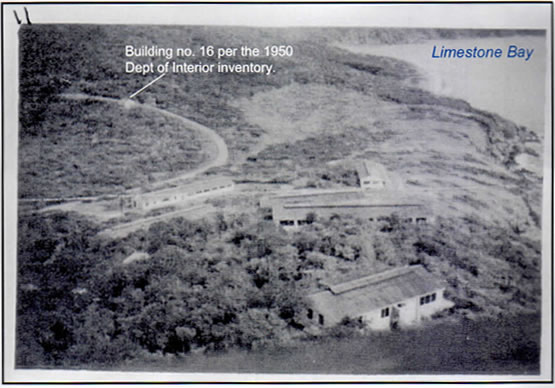

To access the 14.5MB PDF file, US Army Corps of Engineers September 2001 report titled; “Water Island Historical Photo Analysis” click on the below photo
